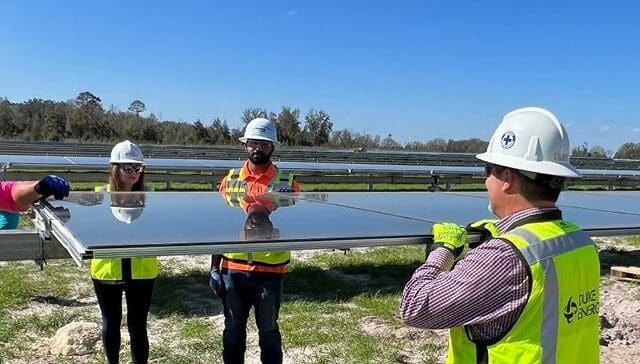Duke Energy has completed two solar projects in Florida. At peak output, each site will generate enough electricity to power the equivalent of around 23,000 homes.
The 74.9-MW High Springs Renewable Energy Center in Alachua County is built on 700 acres (283 ha) and consists of approximately 216,000 single-axis tracking solar panels. The 74.9-MW Hildreth Renewable Energy Center facility sits on 635 acres (257 ha) in Suwannee County and consists of approximately 220,000 single-axis tracking solar panels.
Duke Energy Florida, a subsidiary of Duke Energy, has outlined an investment of more than US$2 billion that will include 25 grid-tied solar power plants. These projects will provide about 1500 MW using approximately 5 million solar panels by 2024.
“The company is well on its way to meeting a major milestone by placing its 21st solar project in operation by the end of this year, delivering on our customer commitment to provide reliable, affordable, clean energy,” said Melissa Seixas, Duke Energy Florida president. “These investments allow Florida customers to enjoy renewable energy, while also providing cost savings by reducing fuel use.”
Based on Duke Energy Florida’s current fuel mix, each 74.9-MW solar facility displaces about 1.2 MMscf (33,980 m3) of natural gas, 15,000 barrels of fuel oil, and 12,000 tons (10,886 tonnes) of coal each year.
Duke Energy Florida owns 10,500 MW of energy capacity, supplying electricity to 1.9 million residential, commercial, and industrial customers across a 13,000-mi2 (33,670-km2) service area in Florida.
Duke Energy is executing an aggressive clean energy transition to achieve its goals of net-zero methane emissions from its natural gas business by 2030 and net-zero carbon emissions from electricity generation by 2050. The company has interim carbon emissions targets of at least a 50% reduction from electric generation by 2030, 50% for Scope 2, and certain Scope 3 upstream and downstream emissions by 2035, and 80% from electric generation by 2040.

















